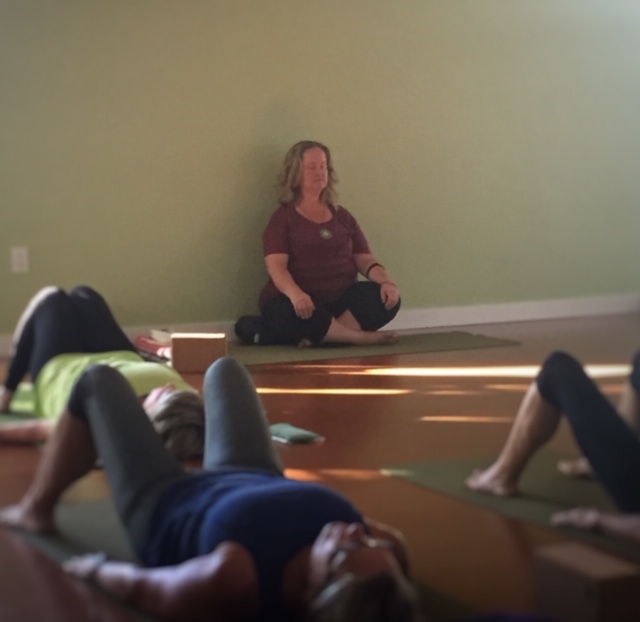By Kimberley Heffley: 2019 TYS Teacher Training Graduate and 15 year 9-1-1 Veteran with the Charlotte County Sheriff’s Department

Kimberley leading her very first group yoga class.
As a group, dispatchers sit. A lot. Upwards of 12 hours for some. Some dispatch centers have consoles that allow you to stand but we are still relatively inactive for long periods-of-time.
Many speak of pain in their bodies; lower back, upper back from hunching over a keyboard, buttocks, etc, which is caused by being idle as well is relatively staying in one spot. Personally, I have felt the discomfort of the sciatic nerve causing an ache to roll down my leg in waves. Trying to ease the pain, I would do all kinds of stretching exercises but could never quite get it to go away. Until I started doing yoga, consistently.
In addition to the daily physical discomfort, the dispatching profession simultaneously exacts a mental toll. Sometimes we are not aware how this may manifest in us. The first time I decided to try an evening class after my 12-hour shift I laid down on the mat, in a constructive rest pose, and allowed myself to relax and just breathe. I let go of the busy shift I had just completed. It was a wild feeling. Had I opened my eyes and looked at myself, I believe I would have literally seen waves of “tension” rolling off my body.
Being mindful of our own bodies can go a long way to help identify and relieve any pain or stress we may face as dispatchers. A beautiful thing about yoga, you can do it right at your console.
A healthy spine can move in seven different directions. In yoga, we work to keep the spine healthy. The following is a common pose used in yoga that moves the spine in two directions.
Chair yoga for the back – Cat/Cow stretches: Sitting at the edge of your seat, spine and side body straight, your hands lightly resting on your legs. Give yourself a moment to just breath. Whatever breathe your body comfortably takes. With an out breath round your back, tilting your pelvis backwards, pulling your belly button to your spine and hunching your shoulders. With an in breathe arch your back, tilting your pelvis forward, allowing your belly to release, broadening your chest and pulling your shoulders backwards. Repeat this action several times.
The human body can survive 8-12 weeks without food, 3-6 days without water, but only 3-6 minutes without air. Simply put, to breathe is to live. In yoga there is an entire branch (or limb) dedicated to just breathing. For a person under stress, like a public safety worker, good breathing techniques can calm you down, raise your energy or keep you balanced.
Practice a breathing technique; Belly breathing: Sit up tall in your chair. Place one hand on your low belly. Inhale slowly through your nose, breathing into your belly instead of your chest, slowly expanding your belly against your hand. Exhale slowly through your nose and feel your belly deflate away from your hand. Continue this a few times, working to make each inhale and exhale slower and deeper. As you continue to inflate and deflate your belly bring a count to your breaths. Perhaps you can only get to the count of three. Maybe you will be able to make it to five. Whatever breath you are able to take let it be comfortable. Keep it balanced. What you breathe in, breath that count out. See if you can pause at the top of your breath and then at the bottom.
Finally, something as simple as a one-minute meditation can help a dispatcher come out of a ”head space” that only brings stress.
One-minute meditation; Look up from your console. Look at something that pleases you. Give yourself one minute to contemplate that image. Does it bring peace? What about it pleases you?
As dispatchers, we’ve been trained to help people during some of their worst moments. Rarely do we get closure about the calls we take. We must be mindful about our own mental and physical health while attending to the public. Yoga can be a powerful tool towards this end for all public safety personnel.
Give yourself the gift of mindfulness. Let it be steady. Let it be easeful.
*This article was originally written for NENA (National Emergency Number Association).
